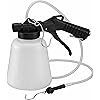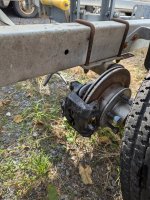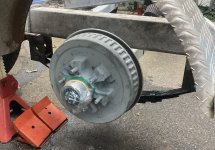demarko210
Senior Chief Petty Officer
- Joined
- Jan 2, 2015
- Messages
- 655
This is my first shot at bleeding brakes the objective is simple, remove the air from the brake line. I purchase this item to do the bleeding.  Port side bleed normal like I would see on youtube. Port side is the furthermost away from the cylinder. Starboard side was acting up. I am bleeding because this side locked up on me going to use the trailer to haul some wood. Disconnecting the caliper from the bracket I notice bad slider pins threads which damage the caliper mounting bracket on both sides. Purchase new pins and brackets and got them in. Grease the piston under the boot and slide pins as I put back on both sides.
Port side bleed normal like I would see on youtube. Port side is the furthermost away from the cylinder. Starboard side was acting up. I am bleeding because this side locked up on me going to use the trailer to haul some wood. Disconnecting the caliper from the bracket I notice bad slider pins threads which damage the caliper mounting bracket on both sides. Purchase new pins and brackets and got them in. Grease the piston under the boot and slide pins as I put back on both sides.
When I bleed the starboard side I did not get any fluid out at all. I was convinced that I need to replace the caliper. I would pump the actuator while the valve was open pulling air and still not fluid would come out. Again thinking I was going to need a caliper, I pulled the valve all the way out and saw the bottom hole was clogged. I stuck a screw in and freed up the hole but I did not have anything to really clean and blow it out at the time. I put the valve back in and tried to bleed again. Now I am getting fluid but with a lot of air. I bleed for about 30 minutes but the air bubbles would not go away from this side. As I bleed the caliper would lock and free up when I closed the valve but the air bubble remain.
I was thinking maybe replace the valve. Any ideas? I am going back over today and clean the valve out good and add some Teflon tape on the thread. I am thinking its leaking from the threads. Any ideas would be great thanks.
Tie down 46304 calipers. System was installed 2021. Hardly 1k miles on it.
 Port side bleed normal like I would see on youtube. Port side is the furthermost away from the cylinder. Starboard side was acting up. I am bleeding because this side locked up on me going to use the trailer to haul some wood. Disconnecting the caliper from the bracket I notice bad slider pins threads which damage the caliper mounting bracket on both sides. Purchase new pins and brackets and got them in. Grease the piston under the boot and slide pins as I put back on both sides.
Port side bleed normal like I would see on youtube. Port side is the furthermost away from the cylinder. Starboard side was acting up. I am bleeding because this side locked up on me going to use the trailer to haul some wood. Disconnecting the caliper from the bracket I notice bad slider pins threads which damage the caliper mounting bracket on both sides. Purchase new pins and brackets and got them in. Grease the piston under the boot and slide pins as I put back on both sides.When I bleed the starboard side I did not get any fluid out at all. I was convinced that I need to replace the caliper. I would pump the actuator while the valve was open pulling air and still not fluid would come out. Again thinking I was going to need a caliper, I pulled the valve all the way out and saw the bottom hole was clogged. I stuck a screw in and freed up the hole but I did not have anything to really clean and blow it out at the time. I put the valve back in and tried to bleed again. Now I am getting fluid but with a lot of air. I bleed for about 30 minutes but the air bubbles would not go away from this side. As I bleed the caliper would lock and free up when I closed the valve but the air bubble remain.
I was thinking maybe replace the valve. Any ideas? I am going back over today and clean the valve out good and add some Teflon tape on the thread. I am thinking its leaking from the threads. Any ideas would be great thanks.
Tie down 46304 calipers. System was installed 2021. Hardly 1k miles on it.
Last edited:
























